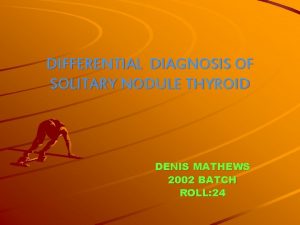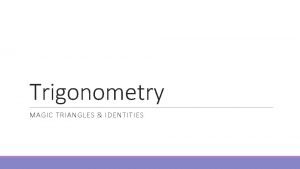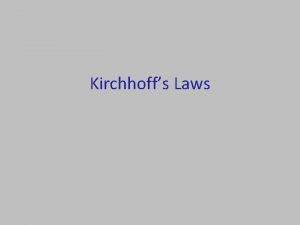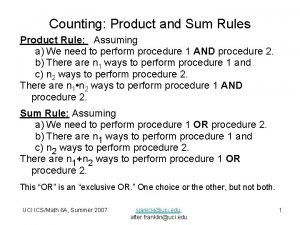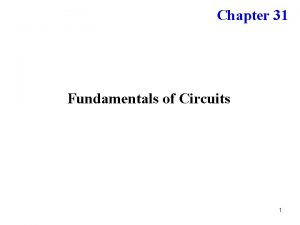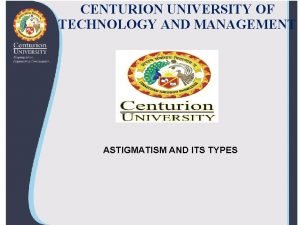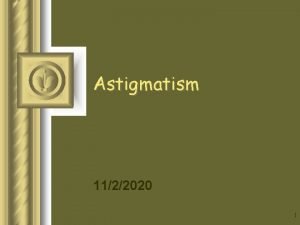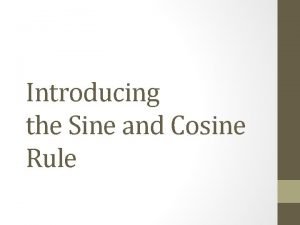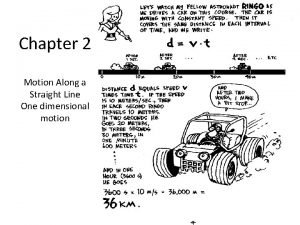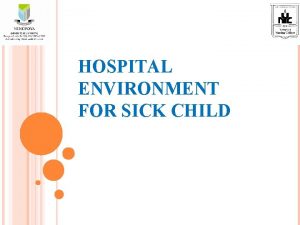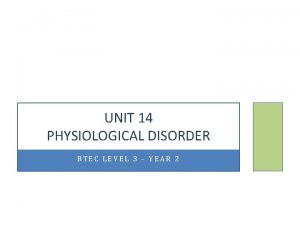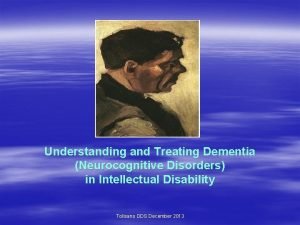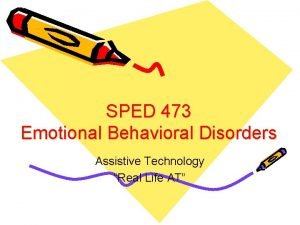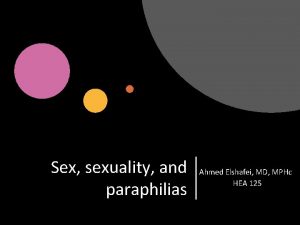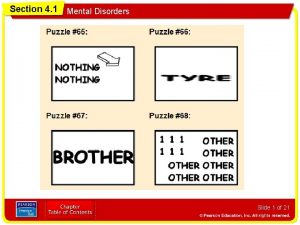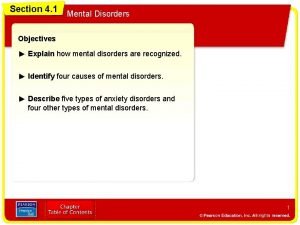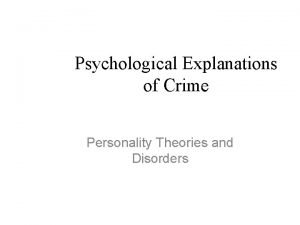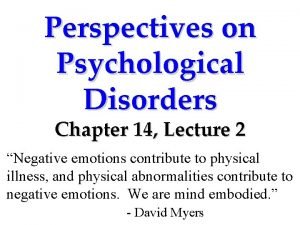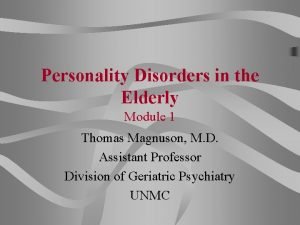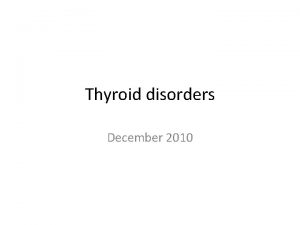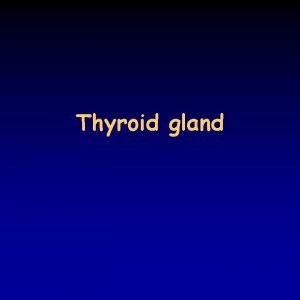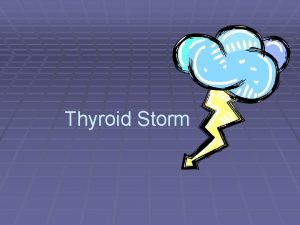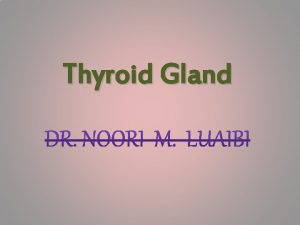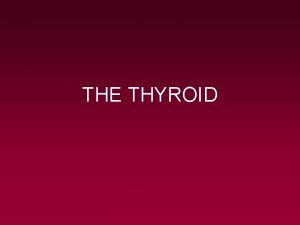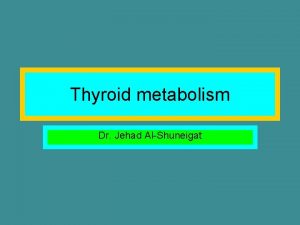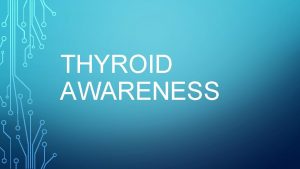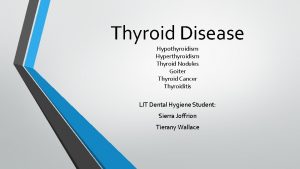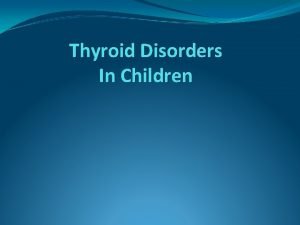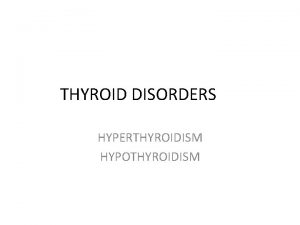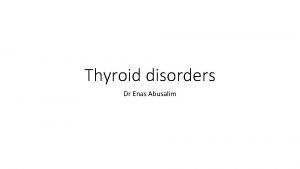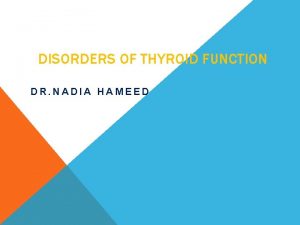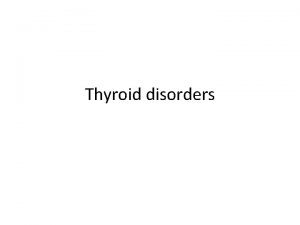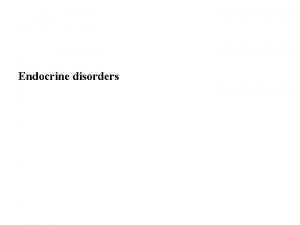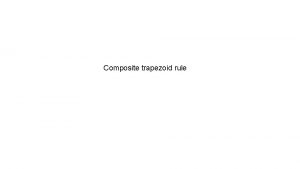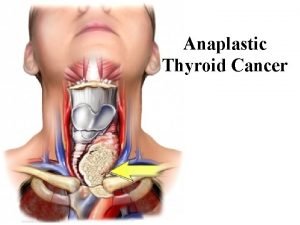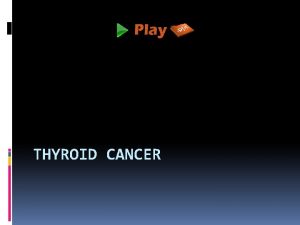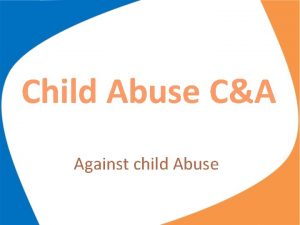Thyroid Disorders INTRODUCTION Thyroid rule In a child










































- Slides: 42

Thyroid Disorders

INTRODUCTION � Thyroid rule: � In a child, critical for normal growth and development. � In an adult, maintain metabolic stability. � Thyroid disorders result in alterations in metabolic stability. Hyperthyroidism and hypothyroidism are the clinical and biochemical syndromes resulting from increased and decreased thyroid hormone production. The common type (hereditary): � Thyrotoxicosis is most commonly caused by Graves’ disease, autoimmune disorder {thyroid-stimulating antibody (TSAb) elicits the same biologic response as thyroid-stimulating hormone (TSH)}. � Hypothyroidism is most often due to an autoimmune disorder known as Hashimoto’s thyroiditis.

Thyroid hormone synthesis lithium block iodide transport into the thyroid. Lithium and iodide(large dose) inhibit thyroid hormone secretion

INTRODUCTION � T 4 and T 3 are transported in the bloodstream by three proteins: thyroidbinding globulin (TBG), thyroidbinding prealbumin, and albumin. It is estimated that 99. 96% of circulating T 4 and 99. 5% of T 3 are bound to these proteins. � Only the unbound (free) thyroid hormone diffuses into the cell, elicit a biologic effect, and regulate (TSH) secretion from the pituitary. � The majority of T 3 is from the breakdown of T 4 by the enzyme 5'monodeiodinase found in peripheral tissues.

Comparing T 4 and T 3 1. T 4 is secreted solely from the thyroid gland; the majority of T 3 is formed from the breakdown of T 4 catalyzed by the enzyme 5'-monodeiodinase found in peripheral tissues. 2. the binding affinity of nuclear thyroid hormone receptors (TRs) is 10 to 15 times higher for T 3 than for T 4. 3. T 3 is about five times more active than T 4. � Thyroid hormone production is regulated by TSH secreted by the anterior pituitary, which in turn is under negative feedback control by the circulating level of free thyroid hormone and the positive influence of hypothalamic thyrotropin-

Pathophysiology � TSH-secreting pituitary tumors release biologically active hormone that is unresponsive to normal feedback control. The tumors may co-secrete prolactin or growth hormone showing amenorrhea, galactorrhea, or signs of acromegaly. � TSH-Induced Hyperthyroidism: Criteria for the diagnosis of TSH-induced hyperthyroidism include, (a) elevated free thyroid hormone levels, (b) elevated or inappropriately “normal” serum immunoreactive TSH concentrations and(c) diffuse thyroid gland enlargement. � In Graves’ disease, hyperthyroidism results from the action of thyroid-stimulating antibodies (TSAb) directed against the thyrotropin receptor on the surface of the thyroid cell in the same manner as TSH.

Pathophysiology Special types of hyperthyroidism: � An autonomous thyroid nodule is a discrete thyroid mass whose function is independent of pituitary and TSH control. � Painful subacute thyroiditis often develops after a viral syndrome. � Thyrotoxicosis factitia was described as “all causes of hyperthyroidism due to ingestion of thyroid hormone � Drug induced: Amiodarone may induce thyrotoxicosis (2% to 3% of patients). It interferes with type I 5'-deiodinase, leading to reduced conversion of T 4 to T 3, and iodide release from the drug may contribute to iodine excess.

General Neck heart skin Body temp weight GIT Hyperthyroidism CLINICAL PRESENTATION nervousness, anxiety, Fatigue, proximal muscle weakness, difficult sleeping Goiter palpitations, systolic ejection murmur warm, smooth, moist skin, onycholysis heat intolerance, sweating loss of weight with increased appetite increased frequency of bowel movements, N and D eye lid lag, exophthalmos (graves only) hair unusually fine hair with hair loss neuron hyperactive deep tendon reflexes, hand tremor � A cardinal sign is loss of weight with an increased appetite. hormona scanty or irregular menses, Gynecomastia in


CLINICAL PRESENTATION • Graves’ disease is manifested by hyperthyroidism, diffuse thyroid enlargement (two to three times the normal size), and the extrathyroidal findings of exophthalmos, and, less commonly, pretibial myxedema, and thyroid acropachy. • An important clinical feature of Graves’ disease is the occurrence of spontaneous remissions (uncommon). The abnormalities in TSAb production may decrease or disappear over time in many patients.

DIAGNOSIS � For differential diagnosis: An elevated 24 -hour radioactive iodine uptake (RAIU) indicates true hyperthyroidism: the patient’s thyroid gland is overproducing T 4, T 3, or both (normal RAIU 10% to 30%). Conversely, a low RAIU indicates that the excess thyroid hormone is not a consequence of thyroid gland hyperfunction but is likely caused by thyroiditis or hormone

DIAGNOSIS � TSH-induced hyperthyroidism is diagnosed by evidence of peripheral hypermetabolism, diffuse thyroid gland enlargement, elevated free thyroid hormone levels and elevated serum TSH concentrations. � TSH-secreting pituitary adenomas are diagnosed by demonstrating lack of TSH response to thyrotropinreleasing hormone stimulation and radiologic imaging.

DESIRED OUTCOME 1. 2. 3. 4. normalize the production of thyroid hormone Relieve symptoms minimize long-term consequences Prevent precipitating factors Treatment guidelines: 1. Antithyroid, RAI or surgery (according to the case). 2. Adjunctive therapy with β-blockers controls the adrenergic symptoms of thyrotoxicosis but does not correct the underlying disorder; iodine may also be used adjunctively in preparation for surgery and acutely for thyroid storm.

Treatment guidelines: Treatment Methimazol e (PTU only 2 nd line) RAI (131 I) surgery Indication (selection) -First line for children, adolescent, pregnancy -Initial therapy in severe cases or preoperative preparation -before RAI, in elderly and with cardiac symptoms of graves -Best treatment for graves disease, and toxic nodule -Anthithyroid Failure -Pregnancy if antithyroid is avoided -Refuse RAI -large gland (>80 g), severe ophthalmopathy -Potential complications (laryngeal nerve damage)

Nonpharmacologic Therapy (surgery) • propylthiouracil (PTU) or methimazole (MMI) is usually given until the patient is biochemically euthyroid (usually 6 to 8 weeks • followed by the addition of iodides (500 mg/day) for 10 to 14 days before surgery to decrease the Before vascularity of the gland • Propranolol has been used for several weeks preoperatively to maintain a pulse rate less than 90 beats/min During After • Surgery • propranolol 7 to 10 days after surgery to maintain a pulse rate less than 90 beats/min.

Nonpharmacologic Therapy Complications of surgery: 1. hypothyroidism (up to about 49%) requires periodic follow -up 2. hyperthyroidism (0. 6% to 18%) 3. hypoparathyroidism (up to 4%) 4. vocal cord abnormalities (up to 5%).

Nonpharmacologic Therapy Smoking Hyperthyroidism: Smoking: worsen the overactive graves disease (specially eye problem and mental) twice more sever symptoms. Hypothyroidism: Thiocyanate, a major component of smoke, derived from hydrogen cyanide, leads to increased excretion of iodine, inhibits iodine uptake by the thyroid, competes with iodide in the organification process and inhibits thyroid hormone synthesis. Diet: diet alone can manage thyroid disorder. Hypothyroidism: avoid eating fatty food, recommend iodine containing diet (like ) specially in iodine deficient areas.

Pharmacological therapy iodide thionamide

Thioureas (Thionamides) PTU (propul thiouracil) Methimazole (MMI) Mech -inhibiting the peroxidase enzyme system of Same but no inhibtion the thyroid gland, -inhibit organification, of peripheral inhibit coupling convesrion -immunosuppresive (week), inhibits the peripheral conversion of T 4 to T 3 in dose dependant manner choic e Second line First line Distri b Bound to plasma protin No placenta or milk passing not protein bound. crosses the placenta, in breast milk. Preg. After the first trimester The first trimester dose 300 to 600 mg daily (usually in three or four divided doses) 30 to 60 mg daily given in three divided doses SE Minor: Rash, leukopenia (transient) Major: agranulocytosis (with fever, malaise, Same but less hepatotoxicity with

Thioureas (Thionamides) � Improvement occur within 4 to 8 weeks (till end of the intrathyroidal pool of thyroid hormone), at which time a tapering regimen to maintenance doses can be started. Dosage changes should be made on a monthly basis. Typical daily maintenance doses are PTU 50 to 300 mg and MMI 5 to 30 mg. � The maximal blocking doses of PTU and MMI are 1, 200 and 120 mg daily, respectively. Maximal response is obtained in 4 to 6 months. � Antithyroid drug therapy should continue for 12 to 24 months to induce a long-term remission. � Patients should be monitored every 6 to 12 months after remission. If a relapse occurs, alternate therapy with RAI is recommended.

Iodides Mechanism: � blocks thyroid hormone release, � inhibits thyroid hormone biosynthesis by interfering with intrathyroidal iodide use, � decreases the size and vascularity of the gland. � Symptom improvement occurs within 2 to 7 days of initiating therapy, and serum T 4 and T 3 concentrations may be reduced for a few weeks. The normal and hyperfunctioning thyroid soon escapes from this inhibitory effect within 1 to 2 weeks by decreasing the active transfer of iodide into the gland. Indication: 1. adjunctive therapy to prepare for surgery 2. to acutely inhibit thyroid hormone release and quickly attain the euthyroid state in severely thyrotoxic patients with cardiac decompensation,

Iodides � Potassium iodide is available as a saturated solution (SSKI, 38 mg iodide per drop) or as Lugol’s solution, containing 6. 3 mg of iodide per drop. � The typical starting dose of SSKI is 3 to 10 drops daily (120 to 400 mg) in water or juice. � Adverse effects: 1. Hypersensitivity reactions (skin rashes, drug fever, rhinitis, conjunctivitis); 2. “iodism” (metallic taste, burning mouth and throat, sore teeth and gums, symptoms of a head cold, and sometimes stomach upset and diarrhea) 3. large doses of iodine may exacerbate hyperthyroidism or indeed precipitate hyperthyroidism iodine-deficient areas.

Adrenergic Blockers (symptomatic tretament) � Many of the manifestations of hyperthyroidism are mediated by β-adrenergic receptors, β-Blockers have been used widely to ameliorate thyrotoxic symptoms such as palpitations, anxiety, tremor, and heat intolerance. � They have no effect on peripheral thyrotoxicosis and protein metabolism and do not reduce TSAb or prevent thyroid storm. � Propranolol and nadolol partially block the conversion of T 4 to T 3, but this contribution to the overall therapeutic effect is small. � β-Blockers are usually used as adjunctive therapy with antithyroid drugs, RAI, or iodides when treating

Adrenergic Blockers � Propranolol initial dose of 20 to 40 mg four times daily is effective for most patients (obtain HR less than 90 beats/min). Younger or more severely toxic patients may require as much as 240 to 480 mg/day. � β-Blockers are contraindicated in patients with decompensated heart failure, sinus bradycardia � Side effects include bradycardia, and hematologic disturbances, nausea, vomiting, anxiety, insomnia, lightheadedness. � Centrally acting sympatholytics (e. g. , clonidine) and calcium channel antagonists (e. g. , diltiazem) may be useful for symptom control when contraindications to β-

Radioactive Iodine � Sodium iodide 131 is an oral liquid that concentrates in the thyroid and initially disrupts hormone synthesis by incorporating into thyroid hormones and thyroglobulin. Over a period of weeks, follicles that have taken up RAI and surrounding follicles develop evidence of cellular necrosis and fibrosis of the interstitial tissue. � RAI is administered as a colorless and tasteless liquid that is well absorbed and concentrates in the thyroid. � RAI is the agent of choice for Graves’ disease, toxic autonomous nodules. Pregnancy is an absolute contraindication to the use of RAI.

Radioactive Iodine � The goal of therapy is to destroy overactive thyroid cells, as a single dose of 4, 000 to 8, 000 rad. It is advisable that a second dose of RAI be given 6 months after the first RAI treatment if the patient remains hyperthyroid. � Side effects: 1. Hypothyroidism commonly occurs months to years after RAI. 2. The acute, short-term side effects include mild thyroidal tenderness and dysphagia. 3. Long-term follow-up has not revealed an increased risk for development of thyroid carcinoma, leukemia.

RAI thionamides prior to RAI ablation because thyroid hormone levels will transiently increase after RAI treatment due to release of preformed thyroid β-Blockers are the primary adjunctive therapy to RAI, hormone. since they may be given anytime without compromising RAI therapy. iodides should be given 3 to 7 days after RAI to prevent interference with the uptake of RAI in the thyroid gland.

EVALUATION OF THERAPEUTIC OUTCOMES � After therapy (thionamides, RAI, or surgery) for hyperthyroidism, evaluate on a monthly basis until they reach a euthyroid condition. � Clinical signs of continuing thyrotoxicosis or the development of hypothyroidism should be noted. � Once T 4 replacement is initiated (if hypothyroidism occur), the goal is to maintain both the free T 4 level and the TSH concentration in the normal range. Once a stable dose of T 4 is identified, the patient may be followed every 6 to 12 months.

Thyroid storm � It is a life-threatening medical emergency characterized by severe thyrotoxicosis, high fever (often greater than 39. 4°C), tachycardia, tachypnea, dehydration, delirium, coma, nausea, vomiting, and diarrhea. � Precipitating factors include infection, trauma, withdrawal from antithyroid drugs.


Hypothyroidis m

PATHOPHYSIOLOGY Uncorrected thyroid hormone deficiency during fetal and neonatal development results in mental retardation and/or cretinism. In adult, There is slowing of physical and mental activity, as well as of cardiovascular, GI, and neuromuscular function. Mainly, thyroid gland failure (primary hypothyroidism) The causes include chronic autoimmune thyroiditis (Hashimoto’s disease), iatrogenic hypothyroidism (after surgery or radiation), iodine deficiency. Pituitary failure (secondary hypothyroidism) is an uncommon cause resulting from pituitary tumors, surgical therapy, external pituitary radiation.

CLINICAL PRESENTATION General Neck Hypothyroidism CLINICAL PRESENTATION lethargy, fatigue, muscle cramps, myalgia, stiffness, and loss of ambition or energy Puffy face, slowed or hoarse speech, goiter heart skin Body temp bradycardia dry coarse skin cold intolerance weight GIT eye hair neuron Sudden Weight gain with poor appetite constipation Periorbital puffiness Dry coarse hair with hair loss slow relaxation of deep tendon reflexes, carpal tunnel syndrome


DIAGNOSIS � Antithyroid peroxidase antibodies and antithyroglobulin antibodies are likely to be elevated. � The RAIU is not a useful test in the evaluation of hypothyroidism. � Pituitary failure (secondary hypothyroidism) should be suspected in a patient with decreased levels of T 4 and inappropriately normal or low TSH levels.

DESIRED OUTCOME � normalize thyroid hormone concentrations in tissue � provide symptomatic relief � prevent neurologic deficits in newborns and children. � Prevent progression of disorder to Myxedema coma Treatment guidelines: 1. Levothyroxin (synthetic T 4) is the DOC. 2. Thyroid, USP (or desiccated thyroid). 3. Thyroglobulin is a purified hog-gland extract (prohibited). 4. Liothyronine (synthetic T 3). 5. Liotrix (synthetic T 4: T 3 in a 4: 1 ratio).

TREATMENT OF HYPOTHYROIDISM � Levothyroxine (Synthetic L-thyroxine, T 4) is the drug of choice for thyroid hormone replacement because: 1. it is chemically stable 2. relatively inexpensive 3. free of antigenicity 4. has uniform potency Levothyroxine results in a pool of thyroid hormone that is readily and consistently converted to T 3. NB: however, any of the commercially available thyroid preparations can be used. Once a particular product is selected, therapeutic interchange is discouraged.

TREATMENT OF HYPOTHYROIDISM � started on 50 mcg daily of levothyroxine and increased to 100 mcg daily after 1 month for older people without cardiac symptoms. for older patients or those with known cardiac disease is 25 mcg/day titrated upward in increments of 25 mcg at monthly intervals to prevent stress on the cardiovascular system. � The average maintenance dose for most adults is about 125 mcg/day. � Pregnancy: Levothyroxine is the drug of choice for pregnant women, and the objective of the treatment is to decrease TSH to 1 m. IU/L. Drug interaction: � Cholestyramine, calcium carbonate, sucralfate, aluminum

TREATMENT OF HYPOTHYROIDISM Thyroid, USP (or desiccated thyroid) is derived from hog, beef, or sheep thyroid gland. It may be antigenic in allergic or sensitive patients. Inexpensive generic brands may not be bioequivalent. Liothyronine (synthetic T 3) has uniform potency but has a higher incidence of cardiac adverse effects, higher cost, and difficulty in monitoring with conventional laboratory tests. Liotrix (synthetic T 4: T 3 in a 4: 1 ratio) is chemically stable, pure, and has a predictable potency but is expensive. It lacks therapeutic rationale because about 35% of T 4 is converted to T 3 peripherally. Side effects: Excessive doses of thyroid hormone cause hyperthyroidism,

EVALUATION OF THERAPEUTIC OUTCOMES � Serum TSH concentration is the most sensitive and specific monitoring parameter for adjustment of levothyroxine dose. Concentrations begin to fall within hours and are usually normalized within 2 to 6 weeks. � TSH and T 4 concentrations should both be checked every 6 weeks until a euthyroid state is achieved. An elevated TSH level indicates insufficient replacement. � In secondary hypothyroidism, alleviation of the clinical syndrome and restoration of serum T 4 to the normal range are the only criteria available for estimating the appropriate replacement dose of levothyroxine. � Given that the half-life of T 4 is 7 days, the appropriate

Myxedema coma � A rare consequence of decompensated hypothyroidism with manifested by myxedema, hypothermia, advanced stages of hypothyroid symptoms, and delirium then coma. Untreated disease is associated with a high mortality rate. � There is impaired conversion of T 4 to T 3. Precipiatating factors include: � Infection (pneumonia, sepsis), not taking medication, sever cold environment, myocardial infarction, heamorrhage)

TREATMENT OF MYXEDEMA COMA 1 -IV bolus levothyroxine, 300 to 500 mcg, Initial treatment with IV liothyronine may be used. 2 -Glucocorticoid therapy with IV hydrocortisone 100 mg every 8 hours. Consciousness, lowered TSH concentrations, and normal vital signs are expected within 24 hours. 3 -Maintenance levothyroxine doses are typically 75 to 100 mcg IV until the patient stabilizes and oral therapy is begun. 4 -Supportive therapy must be instituted to maintain adequate ventilation, blood pressure, and body temperature. Underlying disorders such as sepsis and myocardial infarction must be diagnosed and treated.
 Rule of 12 in thyroid
Rule of 12 in thyroid 이진트리 복사 순회
이진트리 복사 순회 Triangle identities
Triangle identities Obtuse triangle rules
Obtuse triangle rules Cosine rule bbc
Cosine rule bbc Kirchoffs junction rule
Kirchoffs junction rule Rule of sum and rule of product
Rule of sum and rule of product Home rule vs dillon's rule
Home rule vs dillon's rule Kirchhoff's loop law equation
Kirchhoff's loop law equation Oblique astigmatism definition
Oblique astigmatism definition Classification of astigmatism
Classification of astigmatism What is with the rule and against the rule astigmatism
What is with the rule and against the rule astigmatism Product rule
Product rule Chain rule範例
Chain rule範例 Sine and cosine rule
Sine and cosine rule Chain rule power rule
Chain rule power rule Leptokurtotic
Leptokurtotic Introduction modern concept of child care
Introduction modern concept of child care Modern concept of pediatrics
Modern concept of pediatrics Exceptional children an introduction to special education
Exceptional children an introduction to special education Physical environment for sick child in pediatric ward
Physical environment for sick child in pediatric ward Child labour introduction
Child labour introduction Unit 14 health and social care diabetes
Unit 14 health and social care diabetes Unit 14 task 1
Unit 14 task 1 Neurocognitive disorders
Neurocognitive disorders Bipolar and other related disorders
Bipolar and other related disorders Bipolar and other related disorders
Bipolar and other related disorders Flinders model of chronic care self-management limitations
Flinders model of chronic care self-management limitations Assistive technology for emotional disturbance
Assistive technology for emotional disturbance Somatization disorder
Somatization disorder Coprophilic disorder
Coprophilic disorder Types of sensory disorders
Types of sensory disorders Section 4-1 mental disorders answers
Section 4-1 mental disorders answers Section 4-1 mental disorders answers
Section 4-1 mental disorders answers Puberty and autism spectrum disorders
Puberty and autism spectrum disorders Chapter 18 psychological disorders
Chapter 18 psychological disorders Different personality disorders
Different personality disorders Cluster b disorder
Cluster b disorder Axis 1 and axis 2 disorders
Axis 1 and axis 2 disorders Dramatic personality disorders
Dramatic personality disorders Dsm v personality disorders
Dsm v personality disorders Psychological disorders characterized by inflexible
Psychological disorders characterized by inflexible Cluster c personality disorders
Cluster c personality disorders
